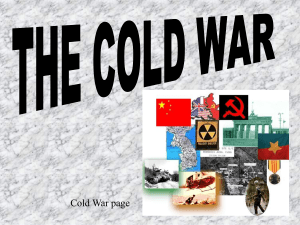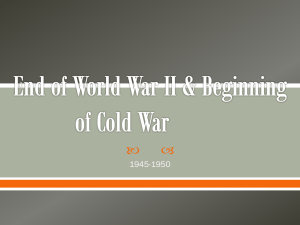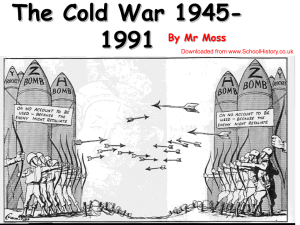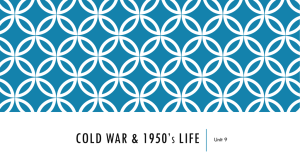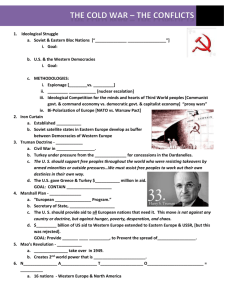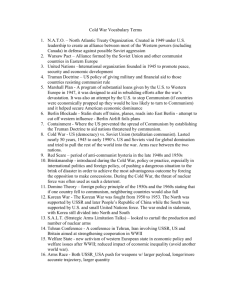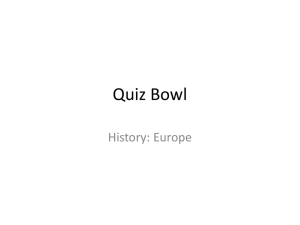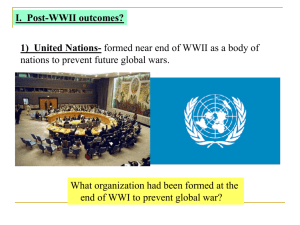The Cold war - Cloudfront.net
advertisement
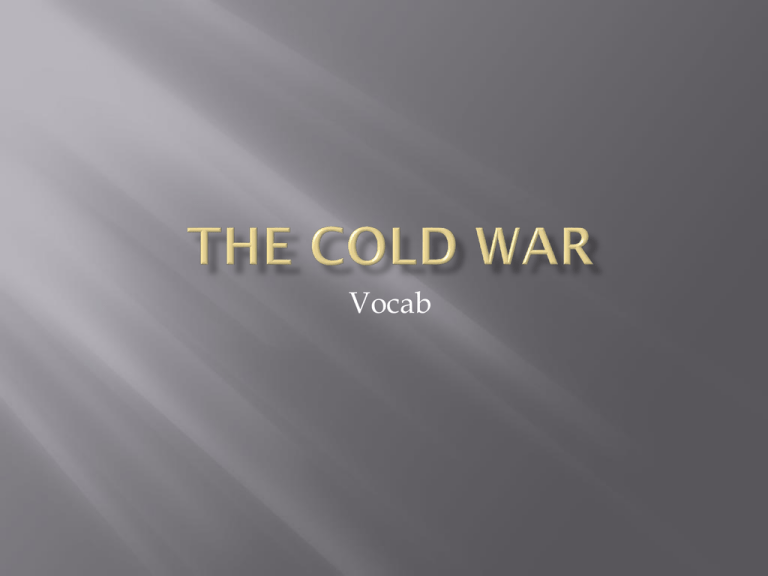
Vocab Cold War: the ideological conflict between the United States and the Union of Soviet Socialist Republics during the second half of the 20th century Iron Curtain: Name given the line that separated Western (Free) Europe and Soviet controlled communist East Europe Superpower: an extremely powerful nation Sphere of Influence: an area not within its own borders where the interest of one large nation are considered to be supreme. Communism: a final stage of society in Marxist theory in which the state has withered away and economic goods are distributed equitably Domino Theory: a theory that if one nation becomes Communist-controlled the neighboring nations will also become Communistcontrolled Satellite Nation: a country that is dominated politically and economically by another nation. Berlin Airlift: a 327day operation in which U.S and British planes flew food and supplies into West Berlin after the Soviets blockaded the city in 1948. Containment: the blocking of another nation’s attempt to spread its influence, especially the efforts of the United States to block the spread of Soviet influence during the late 1940s and early 1950s. North Atlantic Treaty Organization (NATO): a defensive military alliance formed in 1949 by ten Western European countries, the United States, and Canada Ballistic Missile: a rocket-powered object, often carrying a nuclear warhead, which is shot into the air and hits its ground target after a free fall. Collective Security: a system of maintaining world peace and security by concerted action on the part of the nations of the world Blacklist: a list of about 500 actors, writers, producers, and directors who were not allowed to work on Hollywood films because of their alleged Communist connections. Subversives: people who work secretly inside a country to overthrow the government. United Nations: an international peacekeeping organization to which most nations in the world belong, founded in 1945 to promote world peace, security, and economic development. Stalemate: a drawn contest: deadlock. Limited War: President Truman’s plan to keep the Korean War on the Korean Peninsula, rather than enlarging it by attacking China or using nuclear weapons. Brinkmanship: the practice of threatening an enemy with massive military retaliation for any aggression. Berlin Wall: a concrete wall that separated East Berlin and West Berlin from 1961 to 1989, built by the Communist East German government to prevent its citizens from fleeing to the West. Hotline: a communication link established in 1963 to allow the leaders of the United States and the Soviet Union to contact each other in times of crisis. Peaceful Coexistence: competition without war, or a policy of peace between nations of widely differing political systems and ideologies, especially between Communist and non-Communist nations Détente: the flexible policy, involving a willingness to negotiate and an easing of tensions that was adopted by President Richard Nixon and his adviser Henry Kissinger in their dealings with communist nations. SALT 1 Treaty: a five-year agreement between the United States and the Soviet Union, signed in 1972 that limited the nations’ numbers of intercontinental ballistic missiles and submarinelaunched missiles. Glastnost: the open discussion of social problems that was permitted in the Soviet Union in the 1980s. Perestroika: the restructuring of the economy and the government instituted in the Soviet Union in the 1980s.
